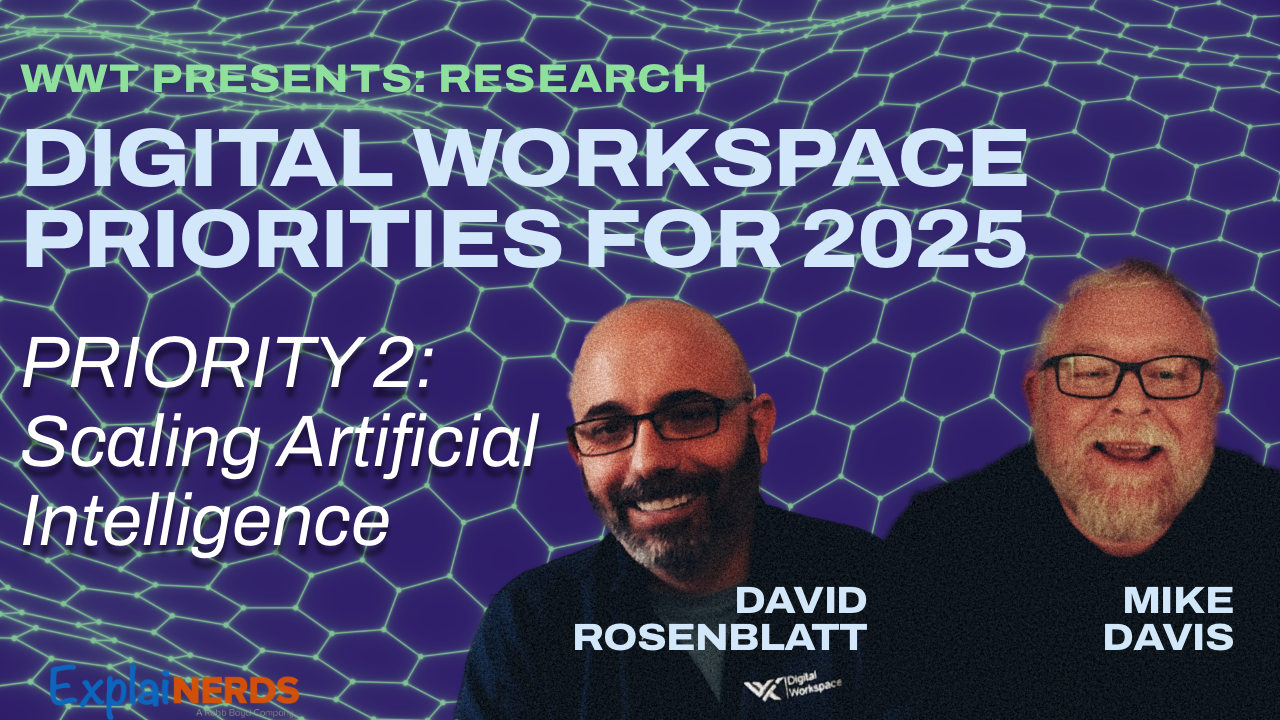Strategic AI Implementation: The Key to Empowering Every Employee
Transform your AI approach from scattered experiments to strategic success. WWT experts David Rosenblatt and Mike Davis reveal key insights from our 2025 Digital Workspace research on scaling AI implementation across your enterprise.

In today's rapidly evolving workplace, a clear divide is emerging: organizations that strategically implement AI at scale are pulling ahead, while those allowing fragmented AI adoption risk falling behind. This isn't just about having AI tools—it's about deploying them thoughtfully and systematically across your entire workforce.
A new research paper from WWT, "Digital Workspace Priorities for 2025," identifies scaling AI usage to empower all employees as one of five critical priorities for organizations. The paper arrives at a pivotal moment, as businesses move beyond AI proof-of-concepts toward deployable, enterprise-wide strategies.
To explore this crucial transition, we spoke with two experts who shared their insights on successful AI implementation: Distinguished Solution Architect David Rosenblatt and Technical Solutions Architect Mike Davis.
From Fragmented to Strategic: The AI Implementation Challenge
Research shows that 75% of global knowledge workers already use AI-powered tools and assistants—often without company clearance. This "shadow AI" adoption signals both an opportunity and a warning: employees are ready to embrace AI, but organizations need to provide proper structure and guidance.
"The challenge isn't finding use cases for AI," explains Rosenblatt. "The real hurdle is transitioning from sporadic, fragmented approaches to establishing a cohesive strategy that provides AI-powered experiences to all employees, regardless of their role, technical skill, or seniority level."
Treating AI Like a New Hire
Rosenblatt suggests a novel framework for scaling AI: treat it like a new employee. "Just as you wouldn't give a new hire unfettered access to everything on day one, AI should be granted access incrementally and thoughtfully," he explains. This approach includes:
- Defining clear roles and responsibilities
- Providing appropriate access and permissions
- Establishing performance metrics
- Implementing proper training and oversight
- Scaling capabilities as integration deepens
The Reality of AI Implementation
Mike Davis brings practical insight from the frontlines of AI adoption, particularly with tools like Microsoft Copilot. "While AI significantly enhances productivity, it doesn't do the job entirely for you," Davis notes. "Users still need to validate, refine, and complete the output."
Davis identifies a common pattern in organizations: a small percentage of "power users" deeply explore and leverage AI, while the majority stick to traditional workflows unless properly incentivized and guided. This highlights the importance of structured implementation and training programs.
The Path Forward: Making AI Work for Everyone
The research paper emphasizes that successful AI scaling requires:
- Strategic Implementation: Move beyond ad-hoc adoption to a comprehensive, organization-wide strategy
- Proper Training: Ensure all employees understand how to effectively use AI tools
- Clear Guidelines: Establish protocols for responsible and secure AI usage
- Monitoring and Adjustment: Use digital experience monitoring (DEM) to track adoption and effectiveness
As Davis points out, "Organizations that fail to adopt AI effectively risk falling behind their peers who are leveraging it as a force multiplier."
Conclusion: The Time for Action is Now
The message is clear: organizations can no longer afford a wait-and-see approach to AI implementation. Those who successfully scale AI across their workforce will create significant competitive advantages in productivity, innovation, and employee satisfaction.
The key is moving from fragmented adoption to strategic implementation that empowers every employee. As Rosenblatt emphasizes, "It's not about replacing humans with AI—it's about enhancing human capabilities across the entire organization."
For more insights on digital workspace priorities and AI implementation strategies, download the complete WWT research paper, "Digital Workspace Priorities for 2025."

